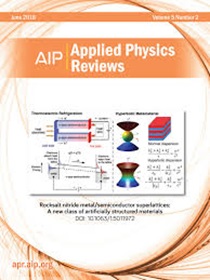III-nitride-based monolithic integration: From electronics to photonics
IF 11.6
1区 物理与天体物理
Q1 PHYSICS, APPLIED
引用次数: 0
Abstract
Over the past two decades, the successful growth of high-quality wide-bandgap III-nitrides has made the realization of a broad range of new device applications, including optoelectronic and microelectronic fields. Through monolithic integration of photonic and electronic devices simultaneously, different functional modules can be integrated on the same wafer, eliminating parasitic effects caused by redundant external components, enhancing system robustness and saving chip area. The scalable integrated circuits have the great potential for optoelectronic hybrid integration. This paper reviews the latest research progress in the monolithic integration of III-nitride devices in optoelectronics and microelectronics in recent years, especially the system integration of gallium nitride-based light emitting diodes, laser diodes, and high-electron-mobility transistors. We further analyze the development status and challenges of photonic integrated circuits and power monolithic integrated circuits from the perspectives of process fabrication and device structure. The applications of III-nitride monolithic integrated systems are presented in detail, including sensing and on-chip optical communication. Finally, we summarize the current state of development, opportunities, and challenges in III-nitride monolithic integration, providing insights into the advancement of wide-bandgap semiconductors in the post-Moore's law era.氮化基单片集成:从电子学到光子学
在过去的二十年里,高质量的宽带隙iii型氮化物的成功发展已经实现了广泛的新器件应用,包括光电和微电子领域。通过将光子器件和电子器件同时进行单片集成,可以将不同的功能模块集成在同一片晶圆上,消除了外部冗余元件带来的寄生效应,增强了系统的鲁棒性,节省了芯片面积。可扩展集成电路在光电混合集成方面具有巨大的潜力。本文综述了近年来光电子学和微电子学中iii -氮化物器件单片集成的最新研究进展,特别是氮化镓基发光二极管、激光二极管和高电子迁移率晶体管的系统集成。进一步从工艺制造和器件结构两方面分析了光子集成电路和功率单片集成电路的发展现状和面临的挑战。详细介绍了iii -氮化物单片集成系统的应用,包括传感和片上光通信。最后,我们总结了iii -氮化物单片集成的发展现状、机遇和挑战,为后摩尔定律时代宽带隙半导体的发展提供了见解。
本文章由计算机程序翻译,如有差异,请以英文原文为准。
求助全文
约1分钟内获得全文
求助全文
来源期刊

Applied physics reviews
PHYSICS, APPLIED-
CiteScore
22.50
自引率
2.00%
发文量
113
审稿时长
2 months
期刊介绍:
Applied Physics Reviews (APR) is a journal featuring articles on critical topics in experimental or theoretical research in applied physics and applications of physics to other scientific and engineering branches. The publication includes two main types of articles:
Original Research: These articles report on high-quality, novel research studies that are of significant interest to the applied physics community.
Reviews: Review articles in APR can either be authoritative and comprehensive assessments of established areas of applied physics or short, timely reviews of recent advances in established fields or emerging areas of applied physics.
 求助内容:
求助内容: 应助结果提醒方式:
应助结果提醒方式:


